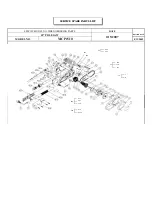
4
• Check the operation and condition of the guard
return spring. If the guard and the spring are
not operating properly, they must be serviced
before use.
The guard may operate sluggishly due
to damaged parts, gummy deposits, or a build-up of
debris.
•
Assure that the base plate of the saw will not
shift while performing a "plunge cut".
Blade
shifting sideways will cause binding and likely kick
back.
•
Always observe that the guard is covering the
blade before placing the saw down on bench
or floor.
An unprotected, coasting blade will cause
the saw to walk backwards, cutting whatever is in
its path. Be aware of the time it takes for the blade
to stop after the switch is released.
Riving knife function
•
Use the appropriate saw blade for the riving
knife.
For the riving knife to function, the body of
the blade must be thinner than the riving knife and
the cutting width of the blade must be wider than
the thickness of the riving knife.
•
Adjust the riving knife as described in this in
-
struction manual.
Incorrect spacing, positioning
and alignment can make the riving knife ineffective
in preventing Kickback.
• Always use the riving knife except when plunge
cutting.
The riving knife must be replaced after
plunge cutting. The riving knife causes interference
during plunge cutting and can create Kickback.
•
For the riving knife to work, it must be engaged
in the workpiece.
The riving knife is ineffective in
preventing Kickback during short cuts.
•
Do not operate the saw if the riving knife is bent.
Even a light interference can slow the closing rate
of a guard.
•
Do not use abrasive wheels.
•
WARNING
To reduce the risk of injury, when
working in dusty situations, wear
appropriate respiratory protection or use an
OSHA compliant dust extraction solution.
• Always use common sense and be cautious when
using tools.
It is not possible to anticipate every
situation that could result in a dangerous outcome.
Do not use this tool if you do not understand these
operating instructions or you feel the work is beyond
your capability; contact Milwaukee Tool or a trained
professional for additional information or training.
•
Maintain labels and nameplates.
These carry
important information. If unreadable or missing,
contact a MILWAUKEE service facility for a free
replacement.
•
WARNING
Some dust created by power sanding,
sawing, grinding, drilling, and other
construction activities contains chemicals known to
cause cancer, birth defects or other reproductive
harm. Some examples of these chemicals are:
• lead from lead-based paint
• crystalline silica from bricks and cement and other
masonry products, and
• arsenic and chromium from chemically-treated
lumber.
Your risk from these exposures varies, depending on
how often you do this type of work. To reduce your
exposure to these chemicals: work in a well ventilated
area, and work with approved safety equipment, such
as those dust masks that are specially designed to
filter out microscopic particles.
SYMBOLOGY
Volts
Direct Current
No Load Revolutions per Minute (RPM)
Match the arrow direction on the saw
blade with the arrow direction on the
saw.
≥1.6 mm
≥0.063"
≤1.3 mm
≤0.051"
Match kerf width of blade (≥1.6 mm)
and blade body thickness (≤1.3 mm)
with the riving knife thickness
(1.4 mm) to reduce the risk of
Kickback.
C
US
UL Listing for Canada and U.S.
SPECIFICATIONS
Cat. No. ..................................................... 2831-20
Volts
..............................................................
18 DC
Battery Type
.................................................
M18™
Charger Type
................................................
M18™
No Load RPM
......................................
2500 - 5600
Blade Size
.....................................6-1/2" (165 mm)
Arbor
.............................................................
20 mm
Bevel Angle Range
.................................. -1° to 48°
Max Depth of Cut at 0°
....................2-1/4" (59 mm)
Max Depth of Cut at 45° ..................1-5/8" (44 mm)
Blade Kerf
..................................≥0.063" (≥1.6 mm)
Blade Body Thickness
...............≤0.051" (≤1.3 mm)
Riving Knife Thickness
..................0.055" (1.4 mm)
Recommended Ambient
Operating Temperature
....................
0°F to 125°F





































